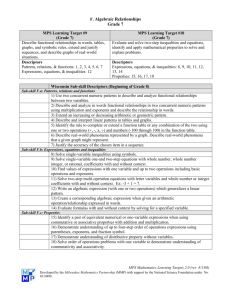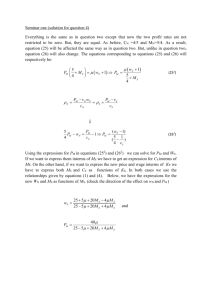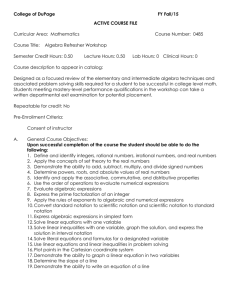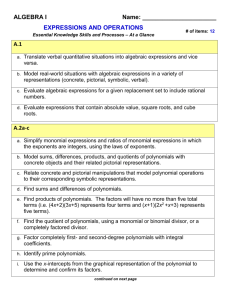Geometry Course Overview: Students will engage in problem
advertisement
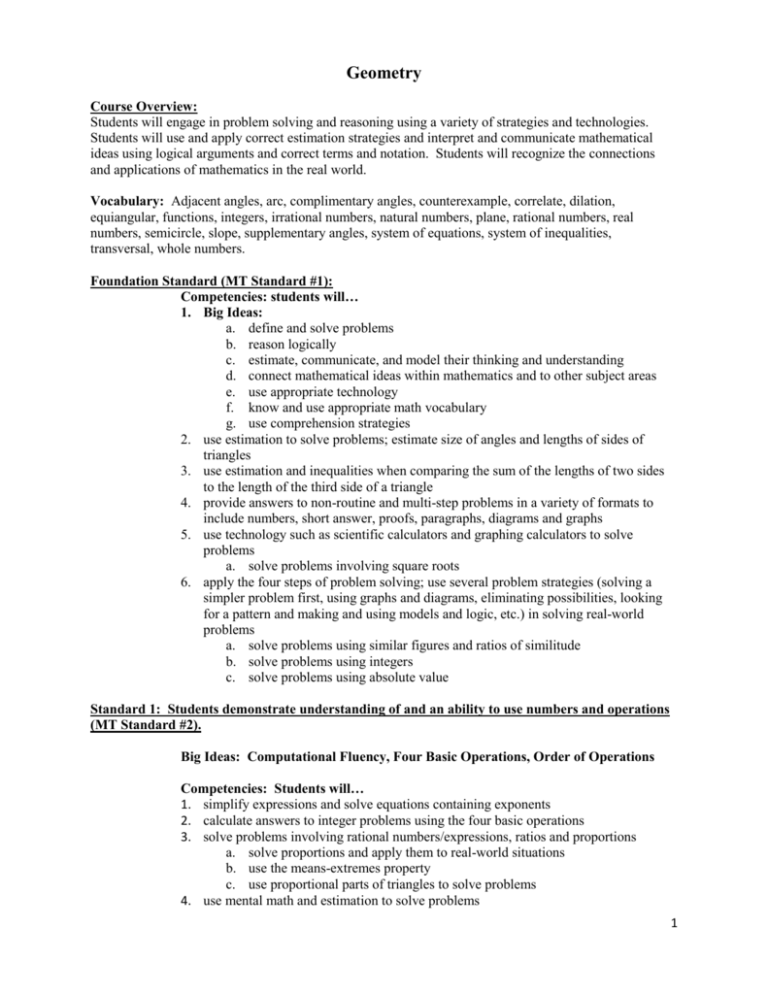
Geometry Course Overview: Students will engage in problem solving and reasoning using a variety of strategies and technologies. Students will use and apply correct estimation strategies and interpret and communicate mathematical ideas using logical arguments and correct terms and notation. Students will recognize the connections and applications of mathematics in the real world. Vocabulary: Adjacent angles, arc, complimentary angles, counterexample, correlate, dilation, equiangular, functions, integers, irrational numbers, natural numbers, plane, rational numbers, real numbers, semicircle, slope, supplementary angles, system of equations, system of inequalities, transversal, whole numbers. Foundation Standard (MT Standard #1): Competencies: students will… 1. Big Ideas: a. define and solve problems b. reason logically c. estimate, communicate, and model their thinking and understanding d. connect mathematical ideas within mathematics and to other subject areas e. use appropriate technology f. know and use appropriate math vocabulary g. use comprehension strategies 2. use estimation to solve problems; estimate size of angles and lengths of sides of triangles 3. use estimation and inequalities when comparing the sum of the lengths of two sides to the length of the third side of a triangle 4. provide answers to non-routine and multi-step problems in a variety of formats to include numbers, short answer, proofs, paragraphs, diagrams and graphs 5. use technology such as scientific calculators and graphing calculators to solve problems a. solve problems involving square roots 6. apply the four steps of problem solving; use several problem strategies (solving a simpler problem first, using graphs and diagrams, eliminating possibilities, looking for a pattern and making and using models and logic, etc.) in solving real-world problems a. solve problems using similar figures and ratios of similitude b. solve problems using integers c. solve problems using absolute value Standard 1: Students demonstrate understanding of and an ability to use numbers and operations (MT Standard #2). Big Ideas: Computational Fluency, Four Basic Operations, Order of Operations Competencies: Students will… 1. simplify expressions and solve equations containing exponents 2. calculate answers to integer problems using the four basic operations 3. solve problems involving rational numbers/expressions, ratios and proportions a. solve proportions and apply them to real-world situations b. use the means-extremes property c. use proportional parts of triangles to solve problems 4. use mental math and estimation to solve problems 1 5. estimate and calculate square roots of numbers 6. use radical expressions and equations Standard 2: Students use algebraic concepts, processes, and language to model and solve a variety of real-world and mathematical problems (MT Standard #3 and #7). Big Ideas: Algebraic Equations and Expressions; Rational Numbers, Patterns, Functions Competencies: Students will… 1. use order of operations to simplify numerical or algebraic expressions 2. solve equations and evaluate expressions that contain variables a. solve and graph linear equations b. describe, represent, and apply the concepts of patterns, variables, expressions, functions, and equations c. translate verbal expressions (words) and charts into numerical or algebraic expressions d. solve quadratic equations by using the quadratic formula 3. solve and graph inequalities, including the four basic operations, multi-step and compound inequalities 4. recognize and use the general properties of operations to simplify and solve expressions and multi-step equations--including distributive, commutative, associative, identity, equality, and inequality properties 5. solve systems of equations in two unknowns 6. use matrices when working with vectors 7. use formulas to find the distance between two points and to find the midpoint of a line segment in the coordinate plane 8. graph lines on the coordinate grid and express the relationships using tables and equations a. solve real-world problems using linear functions b. create scatterplots and estimate a fitted line for the data; relate statistics and equations of lines to geometric concepts 9. explore functions and relations 10. recognize and describe characteristics of fractals Standard 3: Students demonstrate understanding of shape and an ability to use geometry (Montana Standard #4). Big Ideas: Geometric Figures Competencies: Students will… 1. understand and apply geometric properties, concepts, and relationships (Reflexive, Symmetric and Transitive properties) a. measure, sketch, draw, construct, and classify segments and angles; use the relationships that exist among them b. demonstrate an understanding of and an ability to show congruence and similarity of polygons; use the properties of similar figures to solve problems c. use slope to identify parallel and perpendicular line; use the properties of perpendicular and parallel lines to solve problems d. recognize and define parallelogram, rhombi, rectangles, squares, kites, and trapezoids and use their properties to solve problems e. find the measures of interior and exterior angles of polygons 2. rotate, translate, reflect and dilate two-dimensional figures on the coordinate plane 2 3. draw, locate, or describe a locus in a plane or in space 4. determine line symmetry and point symmetry 5. classify and use properties of triangles a. classify triangles by their parts b. apply the Angle Sum and Exterior Angle Theorems and use properties of triangles c. use CPCTC, HL, SSS, SAS, ASA, and AAS to test triangle congruence d. identify and use the special segments in triangles and recognize and apply relationships between the sides and angles in a triangle e. use the properties of 30, 60, 90, and 45, 45, 90 degree triangles and trigonometry to solve problems f. use properties of isosceles and equilateral triangles 6. solve problems involving area, perimeter, volume, lateral and surface area of twoand three-dimensional geometric figures 7. use the Pythagorean theorem and its converse; midpoint formula, and distance formula to solve problems 8. find maximum and minimum values for a given perimeter 9. apply distance relationships among points, lines, and planes 10. identify and model points, lines, and planes in space and on a coordinate plane 11. identify collinear points and coplanar points and lines 12. write, graph, and analyze linear equations using slope, slope-intercept, parallel/perpendicular lines and midpoint 13. solve systems by graphing, substitution, and elimination; explore graphing inequalities 14. find the distance between two points in the coordinate plane and find the midpoint of a line segment in the coordinate plane 15. write algebraic proofs and proofs involving segment and angle theorems 16. make conjectures and use the laws of logic to make conclusions 17. prove lines parallel and right triangles congruent 18. prove theorems using coordinate proofs 19. explore fractals and tessellations 20. analyze, graph, and write equations of circles a. find the degree and linear measures of arcs b. find the measures of angles in circles c. use properties of chords, tangents and secants to solve problems 21. analyze, construct, interpret, and draw three-dimensional figures a. describe and draw cross sections and other slices of three dimensional figures b. make two-dimensional nets for three-dimensional solids Standard 4: Students demonstrate understanding of measurable attributes and an ability to use measurement processes (MT Standard #5). No competencies for this Standard. Standard 5: Students demonstrate an understanding of an ability to use data analysis, probability, and statistics MT Standard #6). No competencies for this Standard. 3



